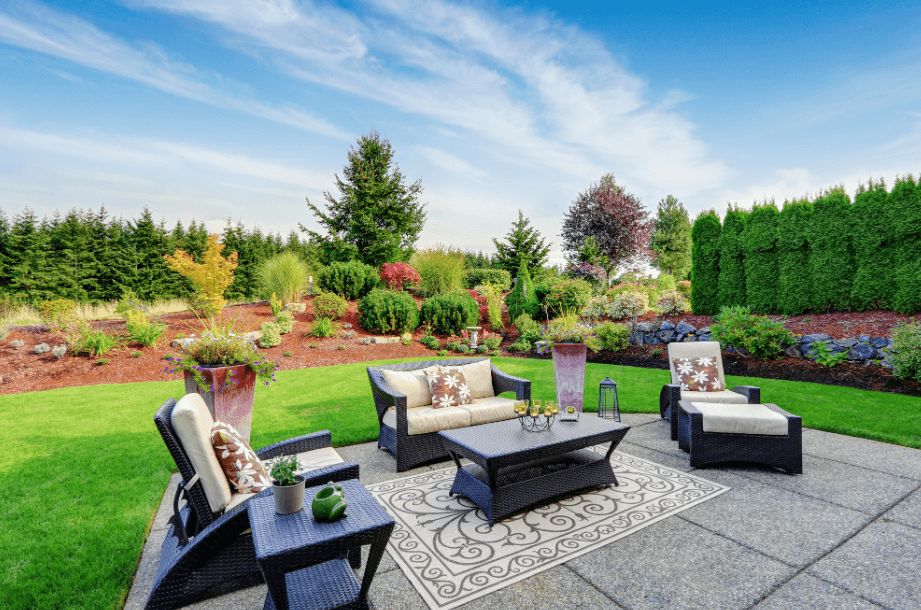Spend much time in your backyard lately? If you’re like most homeowners, renovating the backyard doesn’t always spring immediately to mind. The reason for this is most people don’t realize how easy it is to beautify their property quickly and easily by upgrading the appearance and amenities of their backyard. Knowing what changes to make and how to make them can make all the difference in your remodeling experience, too. Not sure where to start? We can help you put together your dream backyard, but for now here are 7 things to remember when remodeling your backyard.

1. Start With Your Landscaping
If you have ever watched home makeover shows closely, you will note how dramatically a change in landscaping can alter a backyard for the better. Adding or redesigning flowerbeds, adding plants, trees, and even topiaries are quick and easy ways to transform your backyard quickly and inexpensively. Updating the landscaping is the first step to creating a space where you are happy to spend your free time alone or with family and friends.
2. Consider All The Factors That Affect Your Backyard Experience Now
No one can think of everything, but it’s almost a certainty that there are several things you know you want to change about your backyard right now if you could. Don’t let those be the only considerations you make, though. Prevailing weather, seasonal changes, and how you would ideally use the space for you and your family, all need to be reviewed as you plan out your backyard remodeling. Would you prefer a screened in back porch or is a sun tent with mosquito netting in the middle of the backyard more your scene? How will everyone keep cool or warm depending on the time of year? These aren’t the only questions to ask yourself, but they are important nonetheless.
3. Choose Your Outdoor Life
One of the many benefits of living in the 21st century is the ability to explore countless options for outdoor living. Inspired by trends and designs from around the world, anyone can easily make their dream backyard living space a reality.
Prefer the Mediterranean look? Add a plinth and urn or two, install a mosaic to spruce up your concrete patio and add some herbs and spices to your garden. Are you a fan of that Tuscany coast look? Add a pergola with some creeping vines, a fire pit or chiminea. Create a Zen-inspired space with a rock garden, koi pond, and a tea house style seating area or mix and match the best of any style to create a place where you love to be.
4. Choose a Functional Design
Additionally, you’ll want to think about how you want to use the space so that your style fits your functional needs. Those who want to host gatherings need to plan on plenty of comfortable seating areas and potentially an outdoor kitchen. It can be a simple charcoal grill built into a landscaping structure or some masonry/brickwork, or it can be a fully functional outdoor kitchen complete with brick oven, smoker, and wide a propane grill with supplementary charcoal grill.
5. Lighting
Last but not least, don’t forget how you plan to light your new outdoor living space as well. The tone and warmth of your lighting will set the mood for every get-together or a quiet evening in your backyard, so it’s critical to get the lighting just right to make the most of your new entertainment space or personal retreat. Lighting truly is the key to getting the most out of the space and adding some lighting that complements both your functional design and your landscaping.
6. Keep Your Entertainment Space Low Maintenance
Patio or deck, seating area or en-suite outdoor kitchen, make sure you use materials and treat surfaces that will require minimal maintenance on your part. The last thing you want to be doing is pressure washing your patio or having to rebuild your deck because they weren’t properly sealed against the weather and foot traffic. Additionally, outdoor textiles designed to endure weather and sunlight are key for furniture and other outdoor fixtures. Otherwise, you may find yourself needing to replace cushion covers, sunshades, and outdoor living tents on a regular basis. Keeping things low maintenance will help keep your long-term costs to a minimum.
7. Cool Things Off With Water Features and Functional Shade
A small pond or water feature of some kind with a fountain to aerate it helps keep the humidity in your entertaining space comfortable year round and adds a pleasant visual and auditory effect to your outdoor design.
Additionally, well-placed shade trees can actually be as effective in cooling your entertaining space and the sunset side of your home than running an air conditioner day and night. Definitely consider using natural shade to save energy and make your outdoor living space cool and comfortable during the warmer months of the year.
Make Your Backyard Remodeling Into Reality
Need help making all these backyard dreams come true? New Life Rockeries has been in the business of backyard wish fulfillment since 1975, and they are the Seattle local experts on designing and crafting your perfect outdoor space. Contact us today or get a quote, and let us turn your backyard from plain property to your favorite part of being at home.
